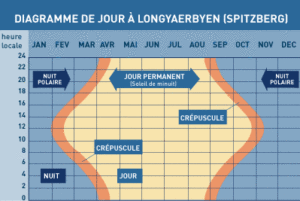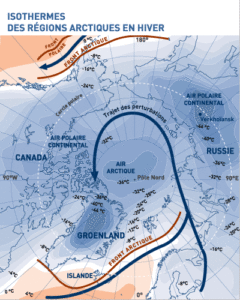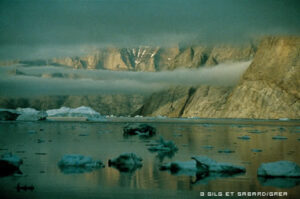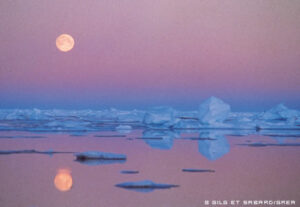
CONTENTS
OCEAN AND MARINE LIFE
- THE ARCTIC OCEAN AND THE OCEAN CURRENTS
- GENESIS OF THE ARCTIC OCEAN
- ARCTIC PLANKTON
- MARINE BIODIVERSITY AND FOOD WEB
- WHALES AND OTHER CETACEANS
- SEALS AND WALRUSES
TERRESTRIAL LIFE
- POLAR FLORA
- POLAR FAUNA
- THE POLAR BEAR
- ARCTIC BIRDS
- SPECIES EVOLUTION AND CLIMATE
HISTORY AND GEOGRAPHY
- GEOGRAPHY OF THE ARCTIC REGIONS
- GEOGRAPHIC NORTH POLE, MAGNETIC NORTH POLE
- WHO OWNS THE ARCTIC?
- THE EXPLORERS OF THE FAR NORTH
- THE INUIT
- OTHER PEOPLES OF THE FAR NORTH
- THE ARCTIC TODAY
EXTREME COLD IN THE FAR NORTH
Permanent continental ice and sea ice: cold characterizes the polar climate. Summer and winter, a very dense, cold air mass stagnates above the Arctic. This is due to the low incident solar illumination. Here, the Earth loses more energy than it receives from the Sun; the remainder is supplied by the ocean and the atmosphere.
9 MONTHS OF WINTER, 3 MONTHS OF SUMMER
The Earth’s sphericity causes climate differences, and its tilt towards the Sun causes the seasons. In the Arctic, there are two main, very unequal seasons: 9 months of a long, dark, and glacial winter, and 3 months of a brief, very cool summer. Spring and autumn last only a few weeks.

COLD AND DROUGHT: A GLACIAL DESERT
At the North Pole, the sky is often clear, even in winter, due to a lack of humidity: the frozen sea cannot evaporate. Precipitation, which is scarce, is comparable to that of a desert! In contrast, the climate of coastal lands is more humid. During the thaw, Atlantic depressions arrive over the sea ice, bringing a little snow, or even rain and fog.
AN EVEN HARSHE CLIMATE ON LAND
In winter, it is less cold on the sea ice (around -40°C at the pole) than on the continents (up to -67°C in Siberia!). However, the coasts are much less cold than the interior of the landmasses. In summer, conversely, continents warm up faster and more intensely than the ocean: up to +36.7°C in Siberia, compared to a temperature of 0°C at the pole.
A CAP OF COLD ABOVE THE POLE
A very dense, cold Arctic air mass is permanently established above the North Pole, creating a high-pressure zone. An astonishing temperature inversion phenomenon is observed there: it is warmer a few hundred meters above sea level than at ground level!
This dense, glacial air mass tends to flow southward; deflected by the Earth’s rotation, this flow gives rise to East/Northeast winds at high latitudes. The Arctic air is covered by polar air, slightly less cold, surrounded, around 60° north, by what is called the polar front. This is a belt of low pressure where westerly winds blow, a true confrontation between the cold boreal air descending from the pole and the warm tropical air rising from the equator.

6 MONTHS OF DAY, 6 MONTHS OF NIGHT
Polar regions experience a great contrast between the perpetual daylight of summer and the darkness of the interminable winter. The Arctic Circle marks the points where the sun no longer crosses the horizon at the solstices: it does not set on June 21 and does not rise on December 21. Its position is due to the tilt of the Earth’s rotational axis relative to the Sun. This boundary is not abstract; it corresponds to the geographical location from which the mythical midnight sun can be observed. Within this circle, as one moves northward, the number of continuous winter nights and permanent summer days gradually increases. At the pole itself, polar night and day each last 6 months!
Thus, for example, in Longyearbyen, Svalbard, the polar night lasts 3 months (November, December, and January) and the permanent daylight (midnight sun) extends over 4 months (May, June, July, August). The polar day is longer because solar rays bend slightly downwards when passing through the very cold lower layers of the atmosphere, which allows the sun to be seen… even when it is already below the horizon!
IN GREENLAND, A HARSHE CLIMATE
In Greenland, the presence of the Arctic’s only true polar ice cap maintains a harsher climate all year round: 10°C colder than at the pole; except on the coast and towards the south, where the Atlantic’s influence becomes more pronounced. This great stability is due to a layer of very cold air covering the ground, always heavier than the upper tropospheric layers; this situation creates a violent gravitational airflow along the slopes, responsible for gusts that can sweep the ground at over 200 km/h (katabatic winds).
WHEN THE ATLANTIC WARMS NORTHERN EUROPE
The coasts of Northern European lands (Iceland, Norway, Svalbard…) are warmed by the northward flow of temperate waters from a branch of the North Atlantic Current, originating from the distant Gulf Stream. These waters locally moderate temperatures, even beyond the Arctic Circle, up to Svalbard: a phenomenon that favors Northern Europeans compared to other Arctic peoples.
THE ARCTIC – ANTARCTIC MATCH
Arctic ice does not cool the atmosphere with as much power as the immense frozen surface of Antarctica, in the Southern Hemisphere. Indeed, in the heart of winter, the continental ice sheet and Austral sea ice reach nearly 35 million square kilometers, 15 million of which are for the ice sheet alone (continental glacier) 3 to 4 kilometers thick: a volume ten times greater than that of the Greenland ice sheet. This permanent ice mass and the formidable temperature contrast that results generate a continuous ring of depressions around the Austral continent and, in winter, a powerful atmospheric vortex that isolates Antarctic air from the rest of the atmosphere: a situation incomparable to that of the Arctic.
THE PHYSICISTS’ CORNER
The polar “cold sink” is accentuated by the whiteness of the snow and ice cover, which reflects most of the incident solar light back into space (albedo).
The density of water is nearly 1000 times greater than that of air, and its viscosity is 60 times higher. The ocean therefore has very high mechanical inertia: currents there are, on average, 100 times slower than winds in the atmosphere.
The specific heat capacity of a substance is the amount of heat required to raise the temperature of one unit of mass of that substance by 1°C, without changing its physical state (phase); it is approximately 4.18×10³ J·K⁻¹·kg⁻¹ (or 1 cal./g/°C according to old units) for seawater and 0.237 for air, at constant pressure. (Not to be confused with latent heat of fusion or vaporization, which is the amount of heat that must be supplied to ensure a change of state of a body, while remaining at constant temperature).
The mass of the atmosphere is approximately 3000 times less significant than that of the ocean, and the specific heat capacity of water is 4 times greater than that of air.
The central Arctic is a distinctly dry region, because, on the one hand, ice releases little water vapor into the atmosphere and, on the other hand, cold air can – according to the laws of physics – contain only little humidity. However, on the periphery, thick fogs can form in summer along the ice-free coasts of lands swept by cold oceanic currents (Canada, Alaska, Svalbard, Kuril Islands, Kamchatka…).
 Coastal Fogs © Gilg & Sabard/GREA
Coastal Fogs © Gilg & Sabard/GREA
JEAN-LOUIS ETIENNE AND THE POLAR CLIMATE
During his solo walk to the Pole, Jean-Louis Etienne naturally had to adapt to the climate; both to the temperature and the light. And try to make the most of it. “On March 6, 1986, when the plane dropped me off alone facing the ice, it was minus 47°C (…).”
“Every evening, regardless of the apparent mildness of the weather, it is better to anticipate, to protect oneself against the violence of the winds, by building an ice wall around the tent. (…) And also: ‘I must constantly orient myself by the Sun, which is very low on the horizon this season: as long as my shadow is in front of me, therefore oriented north, I am sure I am on the right path.’ (Jean-Louis Etienne – Les Pôles, Arthaud, 1992)
During the wintering in Svalbard, the comings and goings of the “warm” North Atlantic Current caused the Antarctica to experience several alternations of freezing and thawing, which sometimes complicated daily life: makeshift arrangements suddenly had to be installed to limit the damage caused by the unexpected melting of ice formed inside the boat by condensation!
Arctic Temperatures
| Pole | Canada
Chesterfield Inlet |
Alaska Coast | Greenland Central |
Svalbard (Longyearbyen) |
Siberia Central |
|
| Avg. January Winter |
+36°C | -33°C | -16°C | -47°C | -12°C | -44°C |
| Absolute Min | -50°C | -64°C | -46.3°C | -67.8°C | ||
| Avg. July Summer |
0°C | +4°C | +8°C | -11°C | +7°C | +16°C |
| Absolute Max | +13°C | +21.3°C | +36.7°C |
Precipitation
| Pole | Western Coasts (Scandinavia/Alaska) |
South Iceland | Eastern Coasts (Labrador/Kamchatka) |
| 150 mm/year | 500 mm/year | 2000 mm/year | 120 cm of snow |
 The Moon, above the Sea Ice © Gilg & Sabard/GREA.
The Moon, above the Sea Ice © Gilg & Sabard/GREA.
DID YOU KNOW?
Frost is caused by the freezing of atmospheric water vapor on the surface of a very cold object. The accumulation of ice that can thus form poses a danger to aircraft, for example. Similarly, frost can occur with sea spray on a ship’s superstructure, potentially destabilizing it. This is a phenomenon well known to Newfoundland fishermen! Frost can also disrupt many human activities due to its insulating, thermal, and electrical properties.
In polar regions, the polar night is less stark and dark than often imagined. Twilight is much longer than at lower latitudes, because, due to the Earth’s tilt and the globe’s sphericity, the sun remains longer in grazing light. It is said that, during a cloudless twilight, when the Sun is 6° below the horizon, one can still read a newspaper. But when the Sun is more than 18° below the horizon, no trace of sunlight reaches us.
In the heart of the polar winter, the Moon is as high in the sky at midnight as the Sun is at noon in summer. Amidst the whiteness of snow and ice landscapes, the Moon is the great beacon of polar nights. And, on the lookout for the slightest glimmer, the eye even perceives the clarity of the stars.
FURTHER READING…
BIBLIOGRAPHY
- The Arctic and the Boreal Environment (P. Avérous – CNDP, 1995)
- Will it Rain, Will it Not – Weather at the Whim of Time (R. Chaboud – Découvertes Gallimard, 1994)
- The Earth’s Climates (B. Voituriez-Explora, Presses Pocket-1992)
- Humans and Climate (J. Labeyrie-Denoël-1993)
- Encyclopedia Universalis
- Earth… Our Planet (P. Avérous-Nathan-1990)
- Atmosphere, Atmosphere (Science & Vie, Special Issue No. 174-1991)
- What Climate for Tomorrow? (S. Huet, Calmann-Levy, 2000)
- The Uncertainty of Climates (R. Kandel, Hachette, 1998)
- Earth’s Climate (R. Sadourny, DOMINOS, Flammarion, 1994)
- Climate, From Yesterday to Tomorrow (S. Joussaume, CNRS Éditions, 1993)


